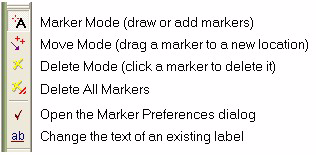![]() Labeling Images
Labeling Images
Labeling refers to drawing text and markers on a displayed image. The displayed labels can be copied with the image for use in graphics arts software or other applications. Adding labels uses the Label Toolbar, which is a standard Command Toolbar. The toolbar opens with Marking Mode active.

Activate the Label command: Use the Measure >
Label menu command or click the ![]() button.
button.
Be sure the drawing Properties are set as
desired. If not, click ![]() to set them.
to set them.
Be sure you are in Marking Mode (the mouse
pointer will recapitulate the ![]() button). If
not, click
button). If
not, click ![]() to activate Marking Mode.
to activate Marking Mode.
To Add labels,
![]() Move the mouse pointer to the
place where you want to create a label and click the mouse. The
Change Label
Text Dialog opens to request text for the label.
Move the mouse pointer to the
place where you want to create a label and click the mouse. The
Change Label
Text Dialog opens to request text for the label.
![]() Enter the label's text into the
edit field. Click [OK] to close the
dialog and add the label to the image.
Enter the label's text into the
edit field. Click [OK] to close the
dialog and add the label to the image.
To Change the text of an existing label, click
the ![]() button on the Label
Toolbar.
button on the Label
Toolbar.
To Delete any label, do one of the following:
![]() Enter Delete mode by clicking
Enter Delete mode by clicking ![]() . Then click the mouse on each label you want to
delete, or
. Then click the mouse on each label you want to
delete, or
![]() Hold down [Shift] while in Addmode and click the mouse on each label you
want to delete.
Hold down [Shift] while in Addmode and click the mouse on each label you
want to delete.
Labels are a non-permanent overlay of the displayed image. In other words, they do not stay with the image data when you save the file. After you have marked labels on an image, you can copy the screen bitmap to the Windows clipboard using the Edit > Copy command in the Image window's menu, then paste into other software using Edit > Paste.
To set label Properties, click ![]() on the toolbar to open the Label Properties dialog.
on the toolbar to open the Label Properties dialog.
Examples of Labeling Images shows the detailed procedure of marking labels on an image.
Label Properties dialog, Label Text dialog, Examples of Labeling Images, Image Windows